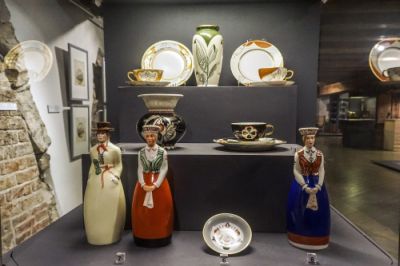
Decorative porcelain of the 1920s-1930s is one of the brightest pages in the history of Latvian art of the 20th century. It reflects the style of this epoch and the most important trend of searches in the national figurative arts.
The government of the young Latvian Republic prohibited the import of ready porcelain products from other countries, leaving the possibility of importing only technical and unornamented (white) houseware. Artists had to search for new forms and motives for ornamenting porcelain items. This situation was favourable for the development of decorative and applied arts. An important constituent of the general background was establishment of the Art Academy of Latvia in 1919, and opening of the ceramics workshop, headed by artist Rudolfs Pelshe, in 1924.
Earlier, in the 19th century, Riga was a centre of well established porcelain production – starting from 1841, one of seven plants of the Kuznetsov’s Partnership was operating here, and from 1886 – a manufacture of the German entrepreneur Jakob Essen. In the 1930s Niklavs Strunke (1894-1966) cooperated with Essen’s porcelain plant and worked at the creation of a uniform style of the public interior, developing sketches of ornamenting plaques, vases, and different functional household items. This is the plant where cruets in the form of figures of girls and boys in national costumes were made for the famous Riga restaurant “Otto Schwartz”.
Up to now, the Museum of Decorative Arts and Design has two copies of porcelain girls, therefore the young man’s figure “Tautas dзls” has become a significant supplement to the original collection of porcelain.
Among different items of porcelain, the museum collection exhibits works from the Baltars workshop, which received the status of an artistic icon of the 20th century for cultivation of the original and individual pattern of artists, and works of masters from the RIPORS and Burtnieks associations. A special contribution to the museum collection is works of professional artists who cooperated with the Kuznetsov and Essen plants – Roman Suta, Aleksandra Belcova, Sigismunds Vidbergs and others.
Riga decorative porcelain can rightly boast of its international recognition and successes received at different exhibitions during the decades. When talking about custom-made works, very few items have remained; therefore, there is huge interest in them. When such items appear at auctions, their prices go sky-high.
The Latvian Museum of Decorative Arts and Design was established in 1989. Since 2010 it is a branch of the Latvian National Museum of Art. The building of the museum – the former Saint George’s Church, which dates back to the 13th century, is the oldest stone building in the entire Baltic Region. The Riga porcelain collection can be seen on the second floor of the museum, where the Latvian Decorative and Applied Arts exposition of the end of the 19th century to the 1960s is located.
Earlier, with the help of the Rietumu Charity Fund, the permanent exposition of the museum was supplemented during recent years with: a unique vase by Marija Rinke (1899–1933) and a rare woven carpet in the national art-deco style made by the outstanding master of Latvian textile art Julijs Straume (1874–1970). Old furniture exhibits were restored, which reflect the search for the “Latvian style” in the 1920s-1930s interior, made according to the sketches of Julijs Madernieks (1870–1955).
Its coordinator is the famous Latvian painter Artur Nikitin, who has succeeded in gathering the brightest and most talented modern artists who work in this unique technique, and created a bright exposition saturated with energy, colours and meaning.